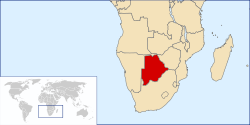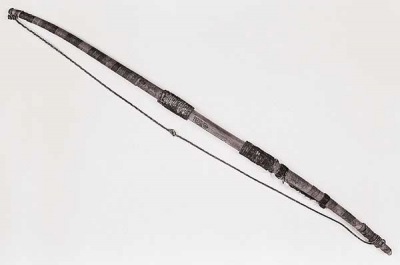Slender bow (1904.56.1)
 BotswanaSlender bow from Botswana, Africa. Collector not known. Purchased by the Museum from Stevens Auction Rooms in 1904.
BotswanaSlender bow from Botswana, Africa. Collector not known. Purchased by the Museum from Stevens Auction Rooms in 1904.
This small slender bow with a sinew string is known as a sou or secca, among the Khoisan (previously also known as the San Bushmen) of Botswana. Its gentle, distinctively asymmetrical form is found only in West Africa.
The Khoisan are one of the great hunter-gatherer peoples of the world and one of the great bow-making peoples of South Africa. Their bows and arrows were regarded by other South African peoples as far superior, and were widely traded and adopted. A Khoisan hunter would use a bow such as this, with arrows tipped with bone or knapped stone heads, to hunt the game of the Kalahari, including elephants and rhinos.
In the late 19th century, when this bow was probably made, ostrich in particular became a valuable commodity due to the widespread use of their feathers by ladies' hatters in Western Europe. To hunt an ostrich, the hunter would watch the nest until nightfall when the mother would return to incubate the eggs as the desert temperature rapidly fell. When the bird settled on the nest, he would shoot it, causing the flock to scatter in terror. In this way, he would gain one bird and the clutch of eggs. The eggs themselves provided food and were invaluable as water carriers.





